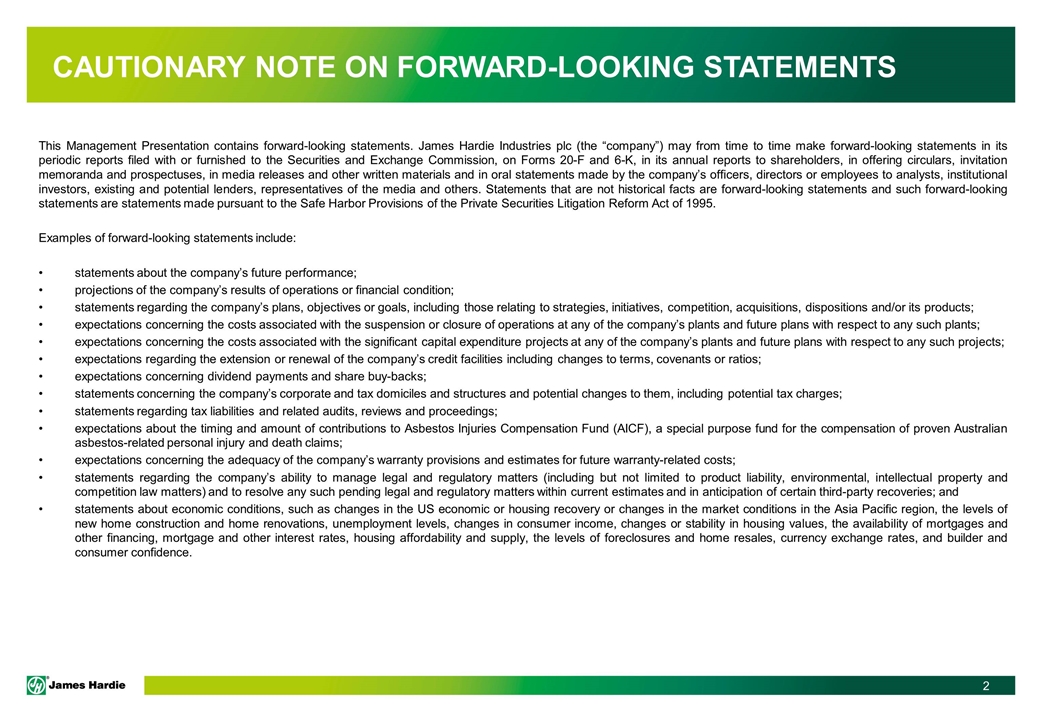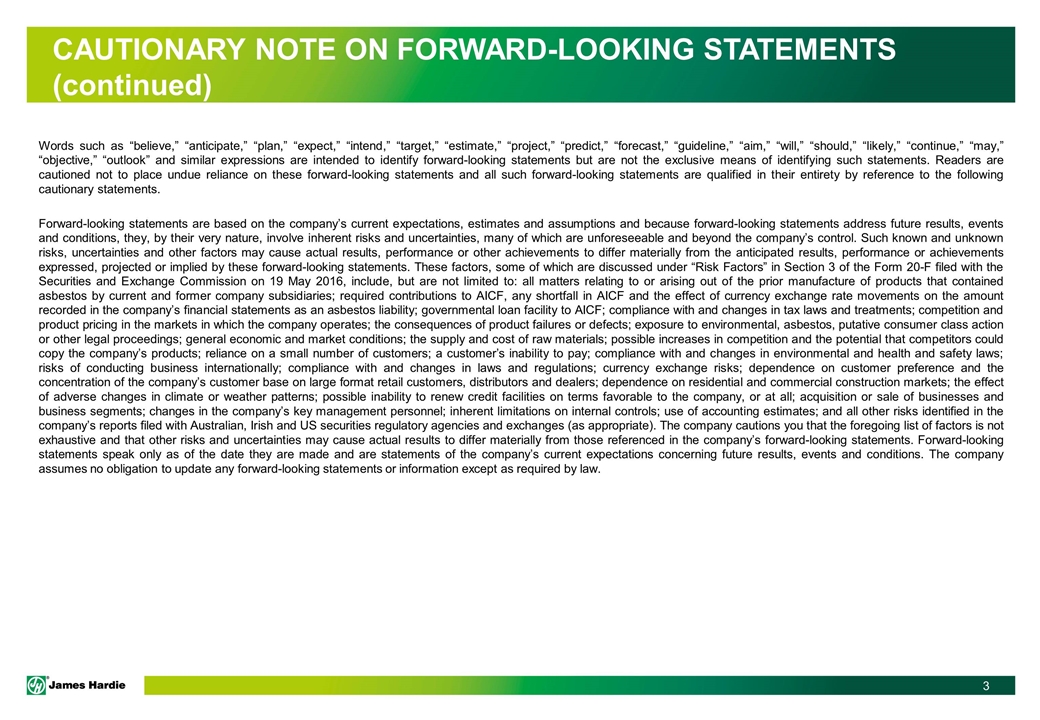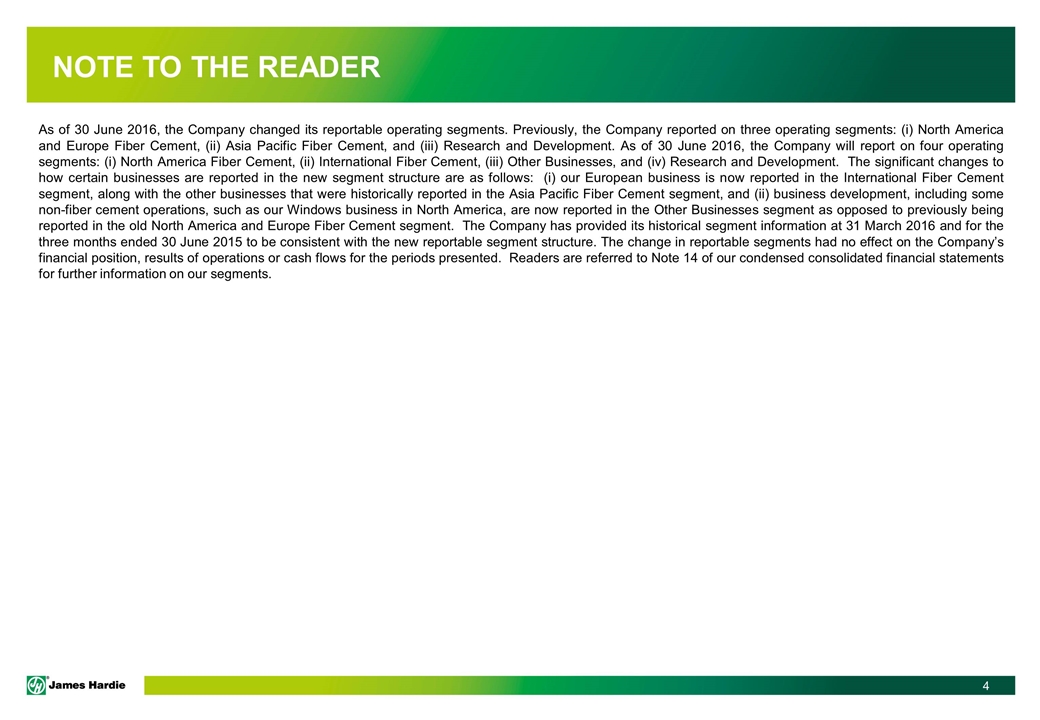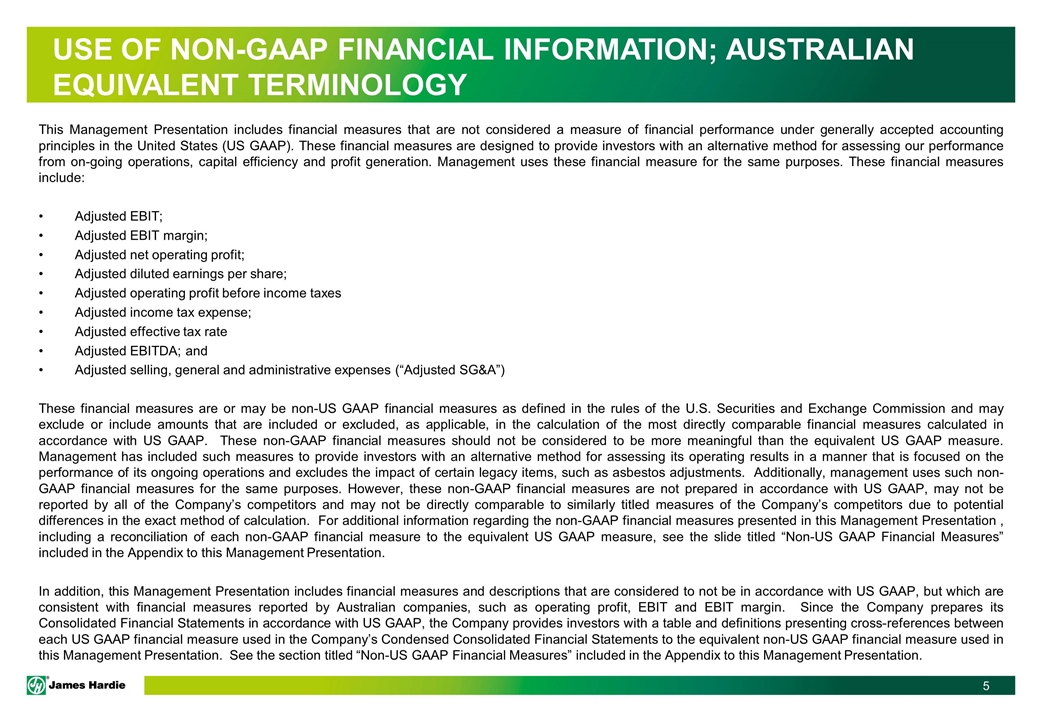

James Hardie - USA Investor/Analyst Tour 15-17 September 2016 Exhibit 99.1

CAUTIONARY NOTE ON FORWARD-LOOKING STATEMENTS This Management Presentation contains forward-looking statements. James Hardie Industries plc (the “company”) may from time to time make forward-looking statements in its periodic reports filed with or furnished to the Securities and Exchange Commission, on Forms 20-F and 6-K, in its annual reports to shareholders, in offering circulars, invitation memoranda and prospectuses, in media releases and other written materials and in oral statements made by the company’s officers, directors or employees to analysts, institutional investors, existing and potential lenders, representatives of the media and others. Statements that are not historical facts are forward-looking statements and such forward-looking statements are statements made pursuant to the Safe Harbor Provisions of the Private Securities Litigation Reform Act of 1995. Examples of forward-looking statements include: statements about the company’s future performance; projections of the company’s results of operations or financial condition; statements regarding the company’s plans, objectives or goals, including those relating to strategies, initiatives, competition, acquisitions, dispositions and/or its products; expectations concerning the costs associated with the suspension or closure of operations at any of the company’s plants and future plans with respect to any such plants; expectations concerning the costs associated with the significant capital expenditure projects at any of the company’s plants and future plans with respect to any such projects; expectations regarding the extension or renewal of the company’s credit facilities including changes to terms, covenants or ratios; expectations concerning dividend payments and share buy-backs; statements concerning the company’s corporate and tax domiciles and structures and potential changes to them, including potential tax charges; statements regarding tax liabilities and related audits, reviews and proceedings; expectations about the timing and amount of contributions to Asbestos Injuries Compensation Fund (AICF), a special purpose fund for the compensation of proven Australian asbestos-related personal injury and death claims; expectations concerning the adequacy of the company’s warranty provisions and estimates for future warranty-related costs; statements regarding the company’s ability to manage legal and regulatory matters (including but not limited to product liability, environmental, intellectual property and competition law matters) and to resolve any such pending legal and regulatory matters within current estimates and in anticipation of certain third-party recoveries; and statements about economic conditions, such as changes in the US economic or housing recovery or changes in the market conditions in the Asia Pacific region, the levels of new home construction and home renovations, unemployment levels, changes in consumer income, changes or stability in housing values, the availability of mortgages and other financing, mortgage and other interest rates, housing affordability and supply, the levels of foreclosures and home resales, currency exchange rates, and builder and consumer confidence.

CAUTIONARY NOTE ON FORWARD-LOOKING STATEMENTS (continued) Words such as “believe,” “anticipate,” “plan,” “expect,” “intend,” “target,” “estimate,” “project,” “predict,” “forecast,” “guideline,” “aim,” “will,” “should,” “likely,” “continue,” “may,” “objective,” “outlook” and similar expressions are intended to identify forward-looking statements but are not the exclusive means of identifying such statements. Readers are cautioned not to place undue reliance on these forward-looking statements and all such forward-looking statements are qualified in their entirety by reference to the following cautionary statements. Forward-looking statements are based on the company’s current expectations, estimates and assumptions and because forward-looking statements address future results, events and conditions, they, by their very nature, involve inherent risks and uncertainties, many of which are unforeseeable and beyond the company’s control. Such known and unknown risks, uncertainties and other factors may cause actual results, performance or other achievements to differ materially from the anticipated results, performance or achievements expressed, projected or implied by these forward-looking statements. These factors, some of which are discussed under “Risk Factors” in Section 3 of the Form 20-F filed with the Securities and Exchange Commission on 19 May 2016, include, but are not limited to: all matters relating to or arising out of the prior manufacture of products that contained asbestos by current and former company subsidiaries; required contributions to AICF, any shortfall in AICF and the effect of currency exchange rate movements on the amount recorded in the company’s financial statements as an asbestos liability; governmental loan facility to AICF; compliance with and changes in tax laws and treatments; competition and product pricing in the markets in which the company operates; the consequences of product failures or defects; exposure to environmental, asbestos, putative consumer class action or other legal proceedings; general economic and market conditions; the supply and cost of raw materials; possible increases in competition and the potential that competitors could copy the company’s products; reliance on a small number of customers; a customer’s inability to pay; compliance with and changes in environmental and health and safety laws; risks of conducting business internationally; compliance with and changes in laws and regulations; currency exchange risks; dependence on customer preference and the concentration of the company’s customer base on large format retail customers, distributors and dealers; dependence on residential and commercial construction markets; the effect of adverse changes in climate or weather patterns; possible inability to renew credit facilities on terms favorable to the company, or at all; acquisition or sale of businesses and business segments; changes in the company’s key management personnel; inherent limitations on internal controls; use of accounting estimates; and all other risks identified in the company’s reports filed with Australian, Irish and US securities regulatory agencies and exchanges (as appropriate). The company cautions you that the foregoing list of factors is not exhaustive and that other risks and uncertainties may cause actual results to differ materially from those referenced in the company’s forward-looking statements. Forward-looking statements speak only as of the date they are made and are statements of the company’s current expectations concerning future results, events and conditions. The company assumes no obligation to update any forward-looking statements or information except as required by law.

NOTE TO THE READER As of 30 June 2016, the Company changed its reportable operating segments. Previously, the Company reported on three operating segments: (i) North America and Europe Fiber Cement, (ii) Asia Pacific Fiber Cement, and (iii) Research and Development. As of 30 June 2016, the Company will report on four operating segments: (i) North America Fiber Cement, (ii) International Fiber Cement, (iii) Other Businesses, and (iv) Research and Development. The significant changes to how certain businesses are reported in the new segment structure are as follows: (i) our European business is now reported in the International Fiber Cement segment, along with the other businesses that were historically reported in the Asia Pacific Fiber Cement segment, and (ii) business development, including some non-fiber cement operations, such as our Windows business in North America, are now reported in the Other Businesses segment as opposed to previously being reported in the old North America and Europe Fiber Cement segment. The Company has provided its historical segment information at 31 March 2016 and for the three months ended 30 June 2015 to be consistent with the new reportable segment structure. The change in reportable segments had no effect on the Company’s financial position, results of operations or cash flows for the periods presented. Readers are referred to Note 14 of our condensed consolidated financial statements for further information on our segments.

USE OF NON-GAAP FINANCIAL INFORMATION; AUSTRALIAN EQUIVALENT TERMINOLOGY This Management Presentation includes financial measures that are not considered a measure of financial performance under generally accepted accounting principles in the United States (US GAAP). These financial measures are designed to provide investors with an alternative method for assessing our performance from on-going operations, capital efficiency and profit generation. Management uses these financial measure for the same purposes. These financial measures include: Adjusted EBIT; Adjusted EBIT margin; Adjusted net operating profit; Adjusted diluted earnings per share; Adjusted operating profit before income taxes Adjusted income tax expense; Adjusted effective tax rate Adjusted EBITDA; and Adjusted selling, general and administrative expenses (“Adjusted SG&A”) These financial measures are or may be non-US GAAP financial measures as defined in the rules of the U.S. Securities and Exchange Commission and may exclude or include amounts that are included or excluded, as applicable, in the calculation of the most directly comparable financial measures calculated in accordance with US GAAP. These non-GAAP financial measures should not be considered to be more meaningful than the equivalent US GAAP measure. Management has included such measures to provide investors with an alternative method for assessing its operating results in a manner that is focused on the performance of its ongoing operations and excludes the impact of certain legacy items, such as asbestos adjustments. Additionally, management uses such non-GAAP financial measures for the same purposes. However, these non-GAAP financial measures are not prepared in accordance with US GAAP, may not be reported by all of the Company’s competitors and may not be directly comparable to similarly titled measures of the Company’s competitors due to potential differences in the exact method of calculation. For additional information regarding the non-GAAP financial measures presented in this Management Presentation , including a reconciliation of each non-GAAP financial measure to the equivalent US GAAP measure, see the slide titled “Non-US GAAP Financial Measures” included in the Appendix to this Management Presentation. In addition, this Management Presentation includes financial measures and descriptions that are considered to not be in accordance with US GAAP, but which are consistent with financial measures reported by Australian companies, such as operating profit, EBIT and EBIT margin. Since the Company prepares its Consolidated Financial Statements in accordance with US GAAP, the Company provides investors with a table and definitions presenting cross-references between each US GAAP financial measure used in the Company’s Condensed Consolidated Financial Statements to the equivalent non-US GAAP financial measure used in this Management Presentation. See the section titled “Non-US GAAP Financial Measures” included in the Appendix to this Management Presentation.